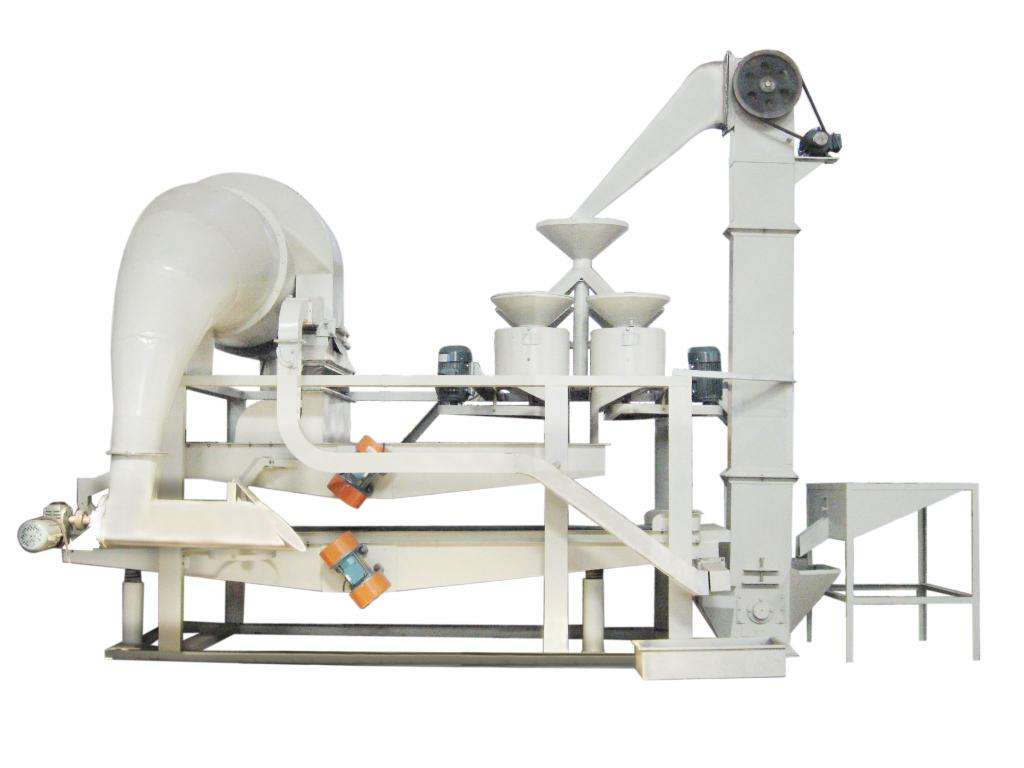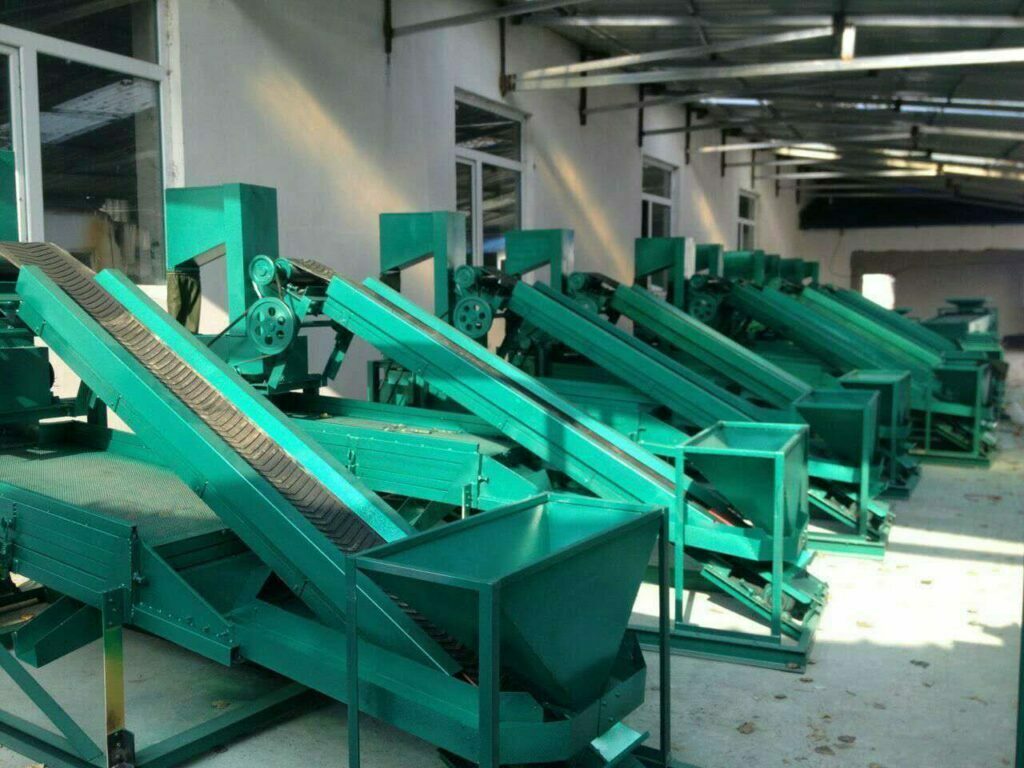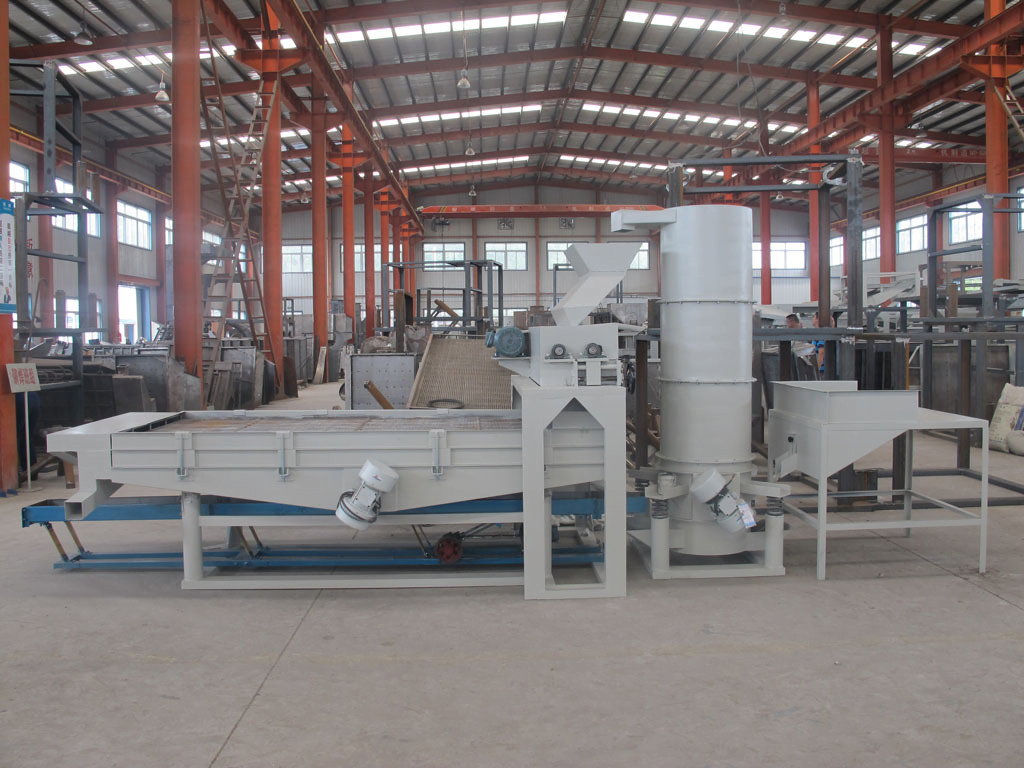How does the machine work
The sheller is composed of a hopper, a spiral elevator, a shelling part, and a screen part. It shells through friction and collision between pine nuts and reduces damage rate.
- Put pine nuts into the hopper.
- The raw materials are elevated into the shelling part.
- Shelled nuts fall onto the screen.
- When passing the sieve part, pine nuts are classified according to their size.
Customers could also make the sheller according to their outputs to increase the opening rate and reduce the broken rate.
A Pine nut shelling machine is an important step of the pine nut production line. Knowing more work details of the machine is helpful.
What influences the price of pine nut sheller machine?
There are some aspects affecting the price of nuts processing machines. The composition of machines, the product it processes, and the output. Customers could choose the parts they need for production, like only a shelling part and a screen. And they could also customize machines to their output. And those factors influence the price of products also do to machines.

Factors affecting the price of pine nuts
Lebanese pine nuts have a natural and delicious taste and light brown appearance. They are rich in fats, proteins, carbohydrates, vitamins, unsaturated fatty acids, and other daily nutrients necessary for the human body. The price of authentic Lebanese pine nuts is generally more expensive. The price of 500 grams is about 70. The color of the exterior is light brown, and the skin is exfoliated. So the question is, there are tens of thousands of pine nuts in a pine tree, why are Lebanese pine nuts so expensive?
Long growth process
Wild pine needs to grow for 50 years before it begins to bear pine nuts, and the maturity period is two years. Strong cold resistance, like slightly acid soil or neutral soil. The wood is light, soft, meticulous, with straight grain and strong corrosion resistance. The seeds are used for edible or medicinal purposes, and the oil can be squeezed for edible and industrial use. The fruit ball is large ovoid, dark brown, knotted inside the ball, as big as croton, deliberately called red pine seed. The long growth cycle has prompted a continuous increase in the price of pine nuts. Some Korean pine trees were cut down before they reached the age of the pine cone, or suffered losses due to natural disasters, pests and diseases.
Harsh growth environment
Red pine trees grow in alpine regions, where the temperature is extremely low each winter and the wind is relatively strong. Because of the low temperature in the production area, the summer is very short and the winter is long. In winter, pine trees do not grow. At this time, they need to fully absorb nutrients to grow in summer. At the same time, there are many wild animals living on pine nuts in the forest, such as squirrels, rats, and so on. Each year before the advent of winter, these animals store a large number of pine nuts for winter use, and many pine nuts are eaten by these small animals.
Difficult to pick
The picking of pine nuts is difficult and the labor cost is high. Red pine trees are generally tens of meters high, and pine nuts are picked manually, which is extremely difficult and dangerous. Pickers climbed to trees that were tens of meters long and beat them down with poles. Only a few experienced farmers would be willing to do this kind of work. Every year there are people who fall from the tree because of picking pine cones. Every year when the pine nut is harvested, some places cannot even hire harvesters at high prices. So the cedar has become the most dangerous job in the world.
Expensive labor costs
Red pine trees grow on the mountain, and the smashed pine cones need to be picked up and put into bags manually. The green pine cones fall into the dense grass, it is difficult to find, the pine cones packed in a bag need to be manually carried back down the mountain. This process is very painful, not only to be bitten by mosquitoes but also to be careful of the rugged mountain roads. People often get injured when carrying pine cones, and a bag of pine cones needs to be carried to a place where cars can walk down the mountain. This process requires the employment of a large amount of labor, and labor is also the most expensive.
The high elimination rate of finished pine nuts
The picked pine cones need to be dried, screened, and peeled in a special processing plant. During this period, some broken pine nuts caused by diseases and insect pests will be eliminated, and some empty pine nuts caused by growth will be screened out. After the whole process, one-third of the pine nuts are generally eliminated. In catching up with the disaster year, most of the pine cones were knocked off by bugs, and a tree was intact when there were not a few pine cones on it. This is one of the reasons why high-quality finished pine nuts are expensive.
Market demand
Lebanese pine nuts have always been favored by market consumers because of their high quality and sweet taste. The freshly processed pine nuts are bought by vendors. After several rounds of turnover, they finally arrive at the counter of the market terminal, and the price will naturally be much higher. At the same time, the annual output of Lebanese pine nuts cannot meet the market demand, so it is difficult for Lebanese pine nuts to be cheap. These points of analysis are the result of the high prices of Lebanese pine nuts.

